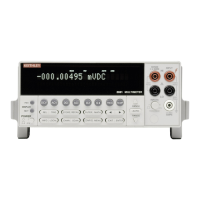IEEE-488 Reference
4-204
Operating considerations:
Before going into a stream mode, make sure the instrument is on the desired function and range.
Once in a stream mode, all front panel controls are disabled, and all SCPI and Common com-
mands are ignored.
Before going into the SSTReam mode, make sure the data format byte order is correct for your
computer. IBM and IBM compatibles require the swapped byte order and HP requires normal
byte order (see :FORMat:BORDer).
Important Note: Before going into a stream mode, the instrument must be in continuous initi-
ation. If continuous initiation is disabled (or you are not sure), send the following command to
enable it:
:INITiate:CONTinuous ON
When the :AMEThod command is sent with one of the stream parameters, the instrument will
go into the stream mode and lock out all front panel controls, and ignore all SCPI and Common
commands. When a stream mode is entered, you must wait before addressing the Model 2001
to talk. The minimum delay period is dependent on function and range (see Table 4-30). In a
stream mode, the instrument configures itself as follows:
Auto zero disabled (:SYSTem:AZERo:STATe OFF)
CALC 1 disabled (:CALCulate[1]:STATe OFF)
Line synchronization disabled (:SYSTem:LSYNc:STATe OFF)
For each valid function:
<function> = :VOLTage:AC
= :VOLTage:DC
= :CURRent:AC
= :CURRent:DC
= :RESistance
Auto range disabled (<function>:RANGe:AUTO OFF)
NPLC = 0.01 (<function>:NPLCycles 0.01)
Auto NPLC disabled (<function>:NPLCycles:AUTO OFF)
Resolution = 4½ digits (<function>:DIGits 4)
Auto resolution disabled (<function>:DIGits:AUTO OFF)
Filter disabled (<function>:AVERage:STATe OFF)
Auto filter disabled (<function>:AVERage:AUTO OFF)
Reference disabled (<function>:REFerence:STATe OFF)
The stream mode is cancelled when a device clear (DCL or SDC) is sent to the Model 2001.
Keep in mind that the instrument will remain at the settings that it assumed for the stream mode.
After cancelling the stream mode, again wait before sending any more commands. (See Table
4-30.)
The delay times in Table 4-30 only account for processing the stream command and the device
clear command. Commands that precede the stream command must be allowed to finish execut-
ing before the stream command is sent. The *OPC? command is recommended for this purpose.
When *OPC? is sent, subsequent commands will not execute until the operations of all previous
commands are completed. The use of *OPC? is demonstrated in Program Example #2.

